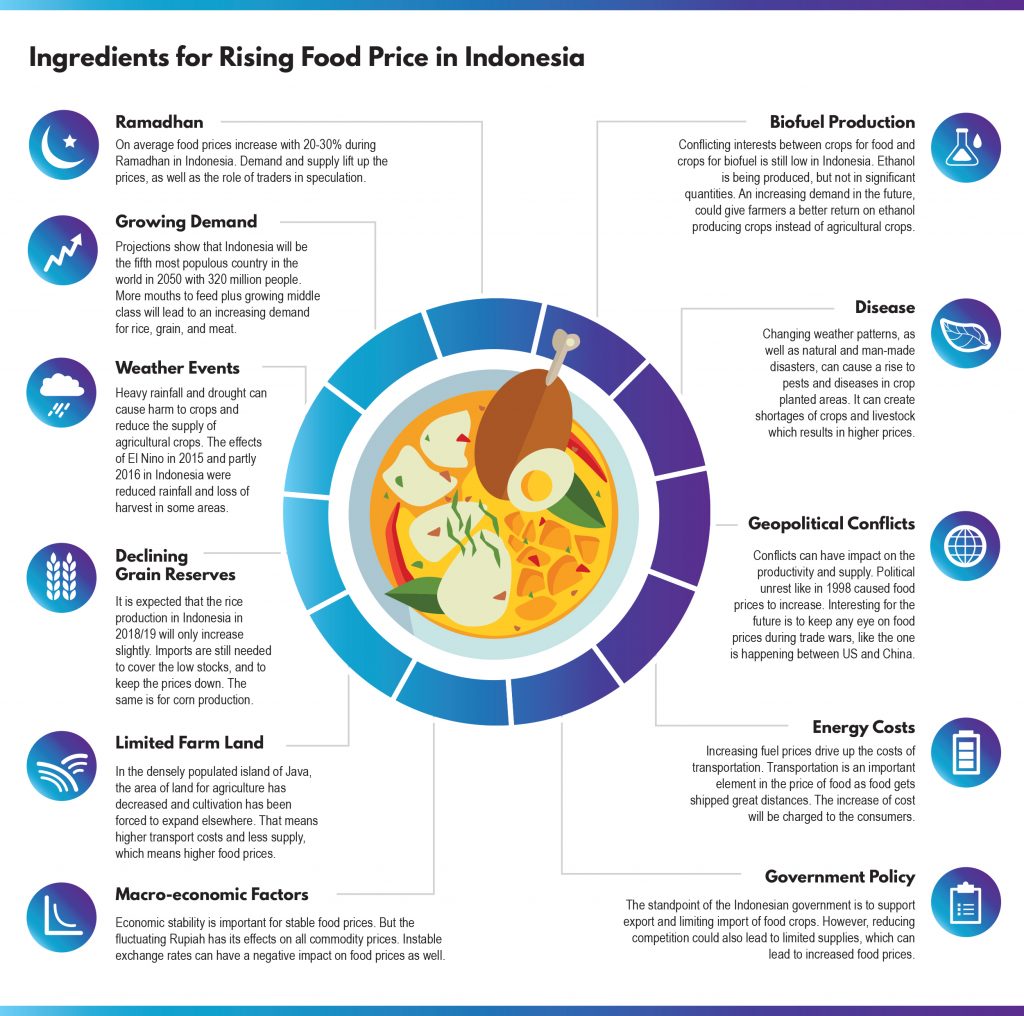Ingredients for rising food prices in Indonesia
Published by Thomas van Rossum on
Every year, a couple of weeks before the start of and during the Ramadhan, the food prices of some vital commodities increase in Indonesia. This is partly, because of lack of supply and high demand of these basic commodities during the fasting season. Another reason is that food distributors have an incentive during this time to drive up the price, justifying it by the lack of supply. Last year around this time (2017), the price of rice increased immensely. For this year, Trade Minister Enggartiasto Lukita promised to regularly check the distribution of rice to ensure stock availability and to stabilize food price during Ramadhan until Eid al-Fitr. The government has formed a “Task Force (Satgas) on Food” to monitor and take firm action against speculators who stock up food especially during Ramadhan and harvest time.
In Indonesia, during the festive season by the end of the year, a similar trend is visible with the same commodities, like rice, chili, garlic, onions and meat. In these examples, demand and supply dynamics and speculation are playing an important role for the rise of food prices. Overall food prices are climbing in Indonesia. According to tradingeconomics.com, cost of food in Indonesia increased 5.15 percent in April of 2018 over the same month in the previous year. It also forecasts a food inflation for the coming months. The Ramadhan and food inflation are just two examples, but with the info-graphic below, we want to give an overview of how other factors can play a role in the rise of food prices in Indonesia. We pick out some of the factors to explain further in this article.
According to a 2015 report from the World Food Programme (WFP), climate change presents risks to the whole food system, from production, through distribution, to consumption. This situation will not be different in Indonesia, as the country likely will experience a temperature rise of approximately 0.8°C by 2030. Although it is hard to claim how climate change will affect food prices, we can assume that more incidents of extreme heat, severe drought, and heavy rains will affect food production and supply. On the long term, these incidents will influence the price of our food. Less sure is the role of water, especially the lack of water to irrigate agricultural land. More cases can be found in Indonesia on longer dry periods in some of the Java areas and the eastern part of Indonesia, with water reservoirs drying up. As water will become scarcer, the price of it will go up. Longer dry spells can also result in land becoming less suitable for farming.
As mentioned in the infographic, limited farm land can lead to higher transportation costs. A second aspect of limited farm land is related to the land ownership of farmers. The government’s trade-off between giving land to businesses over farmers has resulted in the reduction of the number of farmers. It also reduces the amount of land being used for agricultural purposes. Land registration for small holder farmers (one farmer now has an average of only 0.4 hectares of farmland) is important to stop the redistribution of arable land to property builders, mining and commercial business.
The energy use in the food system is found on macro and micro level, from agricultural production, transport, processing, packaging, food retails, food business owners, to home cooking and preparation. The combination of increasing fuel prices with the distance between food producer and consumer drives up the cost of transportation. Consuming food from local farmers is better for the environment and for the local economy. But farmers, agribusiness and the local government need to work together to boost local production for local consumer needs with adequate supply and warehouses, to lower the energy cost and food prices, especially in the transportation and distribution chain.
Rising food prices goes hand in hand with more people requiring food assistance. Household food expenditure in 2016 indicates that 38 percent of Indonesian households cannot afford to buy the least expensive nutritious diet from locally available commodities. A poor household spends on average between 60-70% of their total budget on food. These households will suffer the most from rising food prices. Higher prices can affect the intake of nutritious foods, as people will buy less or less healthy and quality food.
As the fasting month is a time where families come together and eat, it is also a moment to consume wisely and think about where your food comes from. Why are you paying the prices that you pay? This article gives an insight on the dynamics of increasing food prices in Indonesia. Stabilization of food prices is not only the government’s responsibility, also consumers, producers, suppliers and middlemen have a role to play. More on that in a next Agro-Story at agrodite.com
This article is written by:
Thomas van Rossum: Rural Development Expert and Director of Agrodite
Supradani Putri Nurina: Green/Agri Business Advisor and Program Manager of Agrodite
Info-graphic: Supradani Putri Nurina
For more information: www.agrodite.com
Sources:
USDA Foreign Agricultural Service: Indonesia Biofuels Annual Report 2017
USDA Foreign Agricultural Service: Indonesia Grain and Feed Annual Report 2018
Website: https://www.populationpyramid.net/indonesia/2050/ (accessed 14th of May 2018)
World Food Programme: Food Security Monitoring Bulletin (Special Focus: Food Affordability and Ramadan) [English], Vol. VI, April 2017
Oktaviani, Rina; Amaliah, Syarifah; Ringler, Claudia; Rosegrant, Mark W. and Sulser, Timothy B. 2011. The impact of global climate change on the Indonesian economy. IFPRI Discussion Paper 1148. Washington, D.C.: International Food Policy Research Institute.
http://ebrary.ifpri.org/cdm/ref/collection/p15738coll2/id/126762
